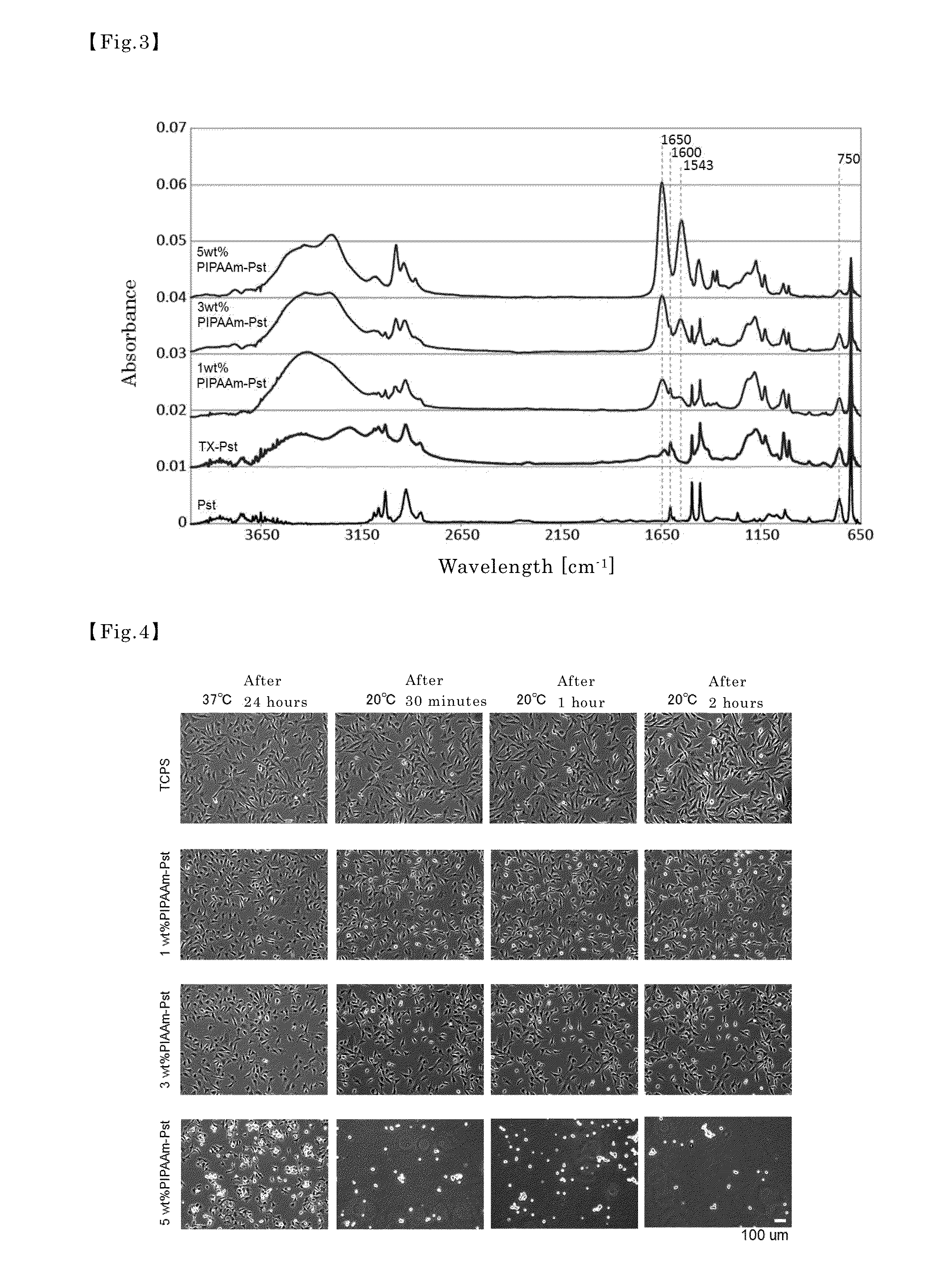Cell culture substrate, and method for manufacturing same
a cell culture substrate and cell culture technology, applied in specific use bioreactors/fermenters, after-treatment of biomass, coatings, etc., can solve the problems of inability to solve this serious problem, inability to find particular efforts, and inability to meet the requirements of substrates, etc., to achieve excellent cell adhesion properties, reduce the cost of industrial production, and reduce the effect of reaction steps
- Summary
- Abstract
- Description
- Claims
- Application Information
AI Technical Summary
Benefits of technology
Problems solved by technology
Method used
Image
Examples
example 1
Manufacture of Temperature Responsive Polymer-Immobilized Surface Using Photopolymerization Initiator
[0069]Thiosalicylic acid (Tokyo Chemical Industry Co., Ltd.) was slowly added to sulfuric acid (Wako Pure Chemical Industries, Ltd.) having a concentration of 95% to give a concentration of 20 mM, and stirred for 10 minutes to prepare a reaction solution. Then, a 2 mL reaction solution was added to each commercially available polystyrene Petri dish (Corning, Inc.), and left to stand for 1 hour at room temperature, and then heated at 65° C. for 3 hours. The sample after the reaction was left to stand at room temperature over night to lower temperature. Then, an unreacted solution was removed and washed with pure water, and drying was performed in an oven at 45° C. An ultraviolet-visible absorption spectrum of a thioxanthone-immobilized polystyrene surface manufactured according to the present approach was measured (FIG. 1). (UV-3101 PC, Shimazu Corporation). Then, to a photopolymeriz...
example 2
Cell Culture on Temperature Responsive Polystyrene Surface Produced by Photopolymerization
[0071]A temperature responsive surface produced as in Example 1 was sterilized with 70% ethanol or ultraviolet irradiation. Endothelial cells from bovine carotid artery (EC) were inoculated at a density of 5.0×104 cells / cm2, and cultured at 37° C. for 24 hours using 10% FBS containing DMEM. Then, medium exchange was performed, and cell culture was performed for 2 hours in an incubator set at 20° C., and detachment behavior of the cells was observed under a phase-contrast microscope.
Results from Cell Culture on Temperature Responsive Polystyrene Surface Produced by Photopolymerization
[0072]Cell adhesion was observed on a 1 wt % PIPAAm-Pst surface and a 3 wt % PIPAAm-Pst surface, but cell detachment when low temperature treatment was performed at 20° C. was not observed even at 2 hours after the treatment. On the other hand, complete cell detachment was observed for a 5 wt % PIPAAm-Pst surface ...
example 3
Preparation of Hydrophilic Patterned Surface by Photopolymerization Using Maskless Irradiation Device
[0073]A 50 wt % aqueous acrylamide (AAm) monomer solution was sandwiched on a photopolymerization initiator-immobilized surface as in Example 2, and irradiated with visible light in a patterned way using a maskless irradiation device to polymerize a hydrophilic polymer AAm. After the reaction, the cover glass and the silicon rubber sheet were removed, and washed with pure water to remove unreacted monomers and unimmobilized polymers. After washing, drying was performed in an oven at 45° C. to obtain a PAAm patterned surface. Next, a 100 μg / ml fluorescent labeled protein solution (Alexa 488-labeled bovine serum albumin; Alexa488-BSA) was adsorbed at room temperature, and the contrast in amounts of the protein adsorbed on the patterned surface was evaluated with fluorescence microscope images. Further, endothelial cells from bovine carotid artery (EC) were inoculated in a density of 5...
PUM
| Property | Measurement | Unit |
|---|---|---|
| temperature | aaaaa | aaaaa |
| temperature | aaaaa | aaaaa |
| emission wavelength | aaaaa | aaaaa |
Abstract
Description
Claims
Application Information
 Login to View More
Login to View More - R&D
- Intellectual Property
- Life Sciences
- Materials
- Tech Scout
- Unparalleled Data Quality
- Higher Quality Content
- 60% Fewer Hallucinations
Browse by: Latest US Patents, China's latest patents, Technical Efficacy Thesaurus, Application Domain, Technology Topic, Popular Technical Reports.
© 2025 PatSnap. All rights reserved.Legal|Privacy policy|Modern Slavery Act Transparency Statement|Sitemap|About US| Contact US: help@patsnap.com



